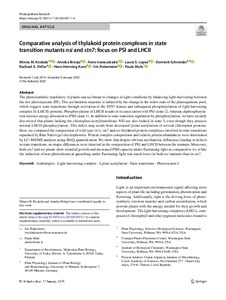Comparative analysis of thylakoid protein complexes in state transition mutants nsi and stn7: focus on PSI and LHCII
Minna M. Koskela; Annika Brünje; Aiste Ivanauskaite; Laura S. Lopez; Dominik Schneider; Rachael A. DeTar; Hans-Henning Kunz; Iris Finkemeier; Paula Mulo
https://urn.fi/URN:NBN:fi-fe2021042824231
Tiivistelmä
The photosynthetic machinery of plants can acclimate to changes in light
conditions by balancing light-harvesting between the two photosystems
(PS). This acclimation response is induced by the change in the redox
state of the plastoquinone pool, which triggers state transitions
through activation of the STN7 kinase and subsequent phosphorylation of
light-harvesting complex II (LHCII) proteins. Phosphorylation of LHCII
results in its association with PSI (state 2), whereas dephosphorylation
restores energy allocation to PSII (state 1). In addition to state
transition regulation by phosphorylation, we have recently discovered
that plants lacking the chloroplast acetyltransferase NSI are also
locked in state 1, even though they possess normal LHCII
phosphorylation. This defect may result from decreased lysine
acetylation of several chloroplast proteins. Here, we compared the
composition of wild type (wt), stn7 and nsi thylakoid
protein complexes involved in state transitions separated by Blue Native
gel electrophoresis. Protein complex composition and relative protein
abundances were determined by LC–MS/MS analyses using iBAQ
quantification. We show that despite obvious mechanistic differences
leading to defects in state transitions, no major differences were
detected in the composition of PSI and LHCII between the mutants.
Moreover, both stn7 and nsi plants show retarded growth
and decreased PSII capacity under fluctuating light as compared to wt,
while the induction of non-photochemical quenching under fluctuating
light was much lower in both nsi mutants than in stn7.
Kokoelmat
- Rinnakkaistallenteet [27094]
